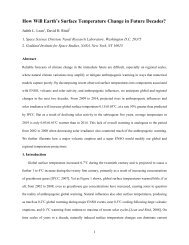Review History - Leif and Vera Svalgaard's
Review History - Leif and Vera Svalgaard's
Review History - Leif and Vera Svalgaard's
- No tags were found...
Create successful ePaper yourself
Turn your PDF publications into a flip-book with our unique Google optimized e-Paper software.
<strong>Review</strong> <strong>History</strong><br />
Dear Dr. Svalgaard:<br />
Thank you for submitting the manuscript "Geomagnetic Semiannual Variation Is Not<br />
Overestimated <strong>and</strong> Is Not an Artifact of Systematic Solar Hemispheric Asymmetry"<br />
(2011GL048161) to Geophysical Research Letters. Based on the reviews, I believe that<br />
your article requires a major revision, <strong>and</strong> therefore I cannot accept this version of your<br />
manuscript for publication (please see Editorial Policies for major revisions at<br />
http://www.agu.org/pubs/pdf/Editorial_GRL.pdf).<br />
You will see that reviewer #2 (reviews enclosed below) found promise in your study.<br />
<strong>Review</strong>er #1, however, mentions that significant additional work <strong>and</strong> explanations are<br />
required for the purported conclusions of the paper to be fully supported by the analysis.<br />
These issues are important <strong>and</strong> would need to be addressed in a substantive <strong>and</strong><br />
constructive way. You may consider exp<strong>and</strong>ing your study <strong>and</strong> submitting a full-length<br />
paper to a more specialized journal such as JGR.<br />
If you believe that a revised manuscript can account for these important comments,<br />
please include a point-by-point response to all reviewer remarks as well as a "trackedchanges"<br />
(changes highlighted or otherwise noted) version of your manuscript when<br />
resubmitting. Please also note that some supporting material may be added as auxiliary<br />
files, if appropriate.<br />
Your revised manuscript will be treated as a resubmission <strong>and</strong> will be subject to rereview.<br />
A resubmit link will be available to you on your homepage. If you use this link,<br />
all of the information from the previous manuscript will be populated in your<br />
resubmission form. This link will be active for 6 months from the receipt of this letter,<br />
but if you need more time, please contact grlonline@agu.org.<br />
Thank you again for your interest in GRL.<br />
Sincerely,<br />
Editor<br />
Geophysical Research Letters<br />
------------------------------------------------------------------------------<br />
<strong>Review</strong>er #1 Evaluations:<br />
Science Category: Science Category 4<br />
Presentation Category: Presentation Category C<br />
<strong>Review</strong>er #1 (Comments to Author):<br />
I have three problems with the manuscript by Svalgaard:
1. There does not appear to be anything new in it. Instead, it is a restatement of previous<br />
work, mostly his own.<br />
2. The author makes a dogmatic defense of the equinoctial hypothesis as an explanation<br />
for the semiannual variation. But the equinoctial hypothesis is not physical, but is,<br />
instead, simply a statement of an observation that magnetic activity seems to be a<br />
function of the angle between the dipole <strong>and</strong> the sun-earth line. There author promotes<br />
phenomenological descriptions of the data that he asserts supports the equinoctial<br />
hypothesis, but in reality the hypothesis does not have enough quantitative power to<br />
support such an exercise. Indeed, the Russell-McPherron hypothesis does not either, <strong>and</strong><br />
without detailed underst<strong>and</strong>ing of solar-terrestrial interaction, there has been little<br />
progress in separating the two hypotheses. Still the role of the axial hypothesis needs to<br />
be considered, as Mursula et al have pursued.<br />
3. Perhaps most importantly, Svalgaard has not looked at the data in the way presented by<br />
Mursula et al. This, I think, is crucial. Mursula et al are trying to unravel a mystery.<br />
Svalgaard is simply denying their results without actually investigating them. I encourage<br />
him to work constructively with other people's results, <strong>and</strong> to try to respectfully consider<br />
their methods. There is much to be learned.<br />
<strong>Review</strong>er #2 Evaluations:<br />
Science Category: Science Category 1<br />
Presentation Category: Presentation Category A<br />
<strong>Review</strong>er #2 (Comments to Author):<br />
This paper is well-written <strong>and</strong> convincing <strong>and</strong> deserves publication with only minor<br />
modifications. It is important to place the Mursula paper in proper context so that it does<br />
not have undue influence.<br />
This manuscript makes assumptions about the reader's knowledge that I suspect are not<br />
justified for GRL. The "axial hypothesis" <strong>and</strong> the "equinoctial hypothesis" are never<br />
defined except indirectly through citations. Several sentences of definition would help the<br />
general reader.<br />
Line 47: Does the longitude dependence of Kp eliminate the semiannual variation or<br />
simply muddle <strong>and</strong> smooth it. Of course no maps in UT-season are possible, but why not<br />
the seasonal variation<br />
Again, IHV index is not well known <strong>and</strong> could use a sentence in addition to the citations.<br />
At line 53 it would be useful to explain why the IHV index eliminates the problem<br />
present in the range indices (K) discussed above.<br />
Line 73: Why does the Mursula effect mean no UT variation
Line 130: The quantity "A" does not seem to be defined anywhere that I could find.<br />
Line 150: This claims that the Rosenberg-Coleman effect is evident in Figure 5. This<br />
certainly requires explanation.<br />
My biggest objection to the manuscript is the lack of discussion of a third cause of the<br />
semiannual variation, the Russell-McPherron effect. This cause is never mentioned until<br />
Line 141. The results of this effect are not mentioned as one of the causes of semiannual<br />
variation. V <strong>and</strong> B alone are not the only drivers of geomagnetic activity; the clock angle<br />
of the IMF around the Earth-Sun line is also important. At equinox the GSEE (or<br />
approximately GSE) IMF By component will project onto the GSM Z-axis with a<br />
positive or negative component dependent on season. Since both toward <strong>and</strong> away sectors<br />
are nearly equally probable the correct orientation will enhance geomagnetic activity near<br />
the equinoxes through magnetic reconnection. Only if one removes this effect in the<br />
strength of the driver does it become apparent that there is still another effect related to<br />
the dipole tilt towards <strong>and</strong> away from the Sun.<br />
There are a few typo problems that I noticed.<br />
Line 37: "...indices respond (to) the same..."<br />
Line 74: "has" should be "have"<br />
=================== upon resubmission ========================<br />
grlonline@agu.org ✆10:36 AM (21 hours ago) June 22, 2011<br />
Thank you for your recent submission to Geophysical Research Letters (Geomagnetic Semiannual<br />
Variation Is Not Overestimated <strong>and</strong> Is Not an Artifact of Systematic Solar Hemispheric Asymmetry, [Paper<br />
#2011GL048616]).<br />
However, we are unable to forward your paper to the Editor to start the peer review process until the<br />
following problems are corrected:<br />
*******I apologize for the inconvenience; however, your manuscript exceeds the GRL by 1 page. I<br />
suggest that you cut text, reduce the number of figures, combine figures, or, if appropriate, consider moving<br />
material to the auxiliary option. Please visit: http://www.agu.org/pubs/authors/pub_fees/calculator.shtml to<br />
check the length of your manuscript once you've made modifications. This will give you the most accurate<br />
length count. Thank you for your cooperation.<br />
*******GRL ask that not more than 4 figures be submitted. There are times that 5 are submitted.<br />
=============<br />
<strong>Leif</strong> Svalgaard ✆ to grlonline 1:19 PM (18 hours ago)<br />
I have reduced the number of Figures to 5. [actually just combined some Figures] As regards the length, the<br />
manuscript was acceptable as far as length was concerned earlier. I have added half a page of new test as a<br />
response to a reviewer, <strong>and</strong> now your length calculator tells me to cut 5 pages of text. Is there a way you<br />
can check the actual file<br />
=============
<strong>Leif</strong> Svalgaard ✆ to grlonline 1:48 PM (18 hours ago)<br />
As you have closed access to the manuscript I can't test if my article file is good. I therefore attached it as a<br />
TeX file. Driving blind like this is extremely frustrating.<br />
==============<br />
<strong>Leif</strong> Svalgaard ✆ to grlonline 2:38 PM (17 hours ago)<br />
And I have gotten it further down. I can't see why it wont fit. In the two column format it takes up only 4<br />
pages. I need help with this.<br />
==============<br />
<strong>Leif</strong> Svalgaard ✆ to grlonline 4:51 PM (15 hours ago)<br />
With 4 Figures it all fits comfortably on 5 pages, see attached. I need help on this one. The text is only 2.5<br />
pages. It cannot be cut anymore.<br />
==============<br />
grlonline ✆ to leif 3:45 AM (4 hours ago)<br />
Dear Dr. Svalgaard:<br />
I see how you made it fit but I cannot go by your 2 column manuscript. We calculate from a manuscript in<br />
draft form. You can submit this one in draft <strong>and</strong> we will check the calculator <strong>and</strong> see if it fits GRL<br />
requirement.<br />
==============<br />
<strong>Leif</strong> Svalgaard ✆ to grlonline 6:57 AM (1 hour ago)<br />
I have attached the PDF of the article <strong>and</strong> the TeX file generating it. The abstract <strong>and</strong> the Figure captions<br />
come from GEMS I presume.<br />
==============<br />
grlonline ✆ to leif 7:22 AM (35 minutes ago)<br />
Dear Dr. Svalgaard:<br />
You need to ADD the abtract <strong>and</strong> figure captions. They do not come from GEMS. Once you do that, use<br />
the online calculator to determine the number of pages your manuscript will be.<br />
==============<br />
<strong>Leif</strong> Svalgaard ✆ to grlonline 7:34 AM (24 minutes ago)<br />
Then why do I need to input them to GEMS Attached is the PDF <strong>and</strong> the Tex file with Abstract <strong>and</strong><br />
Captions included. It comes to 16 pages. The calculator says that I have to cut that to 10 pages. That is<br />
removing 6 pages. This is quite impossible. Also the first version of this paper was fine length-wise <strong>and</strong> I<br />
have only added half a page <strong>and</strong> removed 3 Figures. This does not make sense. What to do<br />
==============<br />
grlonline ✆ to leif 7:41 AM (17 minutes ago)<br />
This one looks fine. Submit it <strong>and</strong> I will move it on.<br />
==============<br />
<strong>Leif</strong> Svalgaard ✆ to grlonline 7:47 AM (12 minutes ago)<br />
How do I submit it You have to give me a link that allows that.
==============<br />
grlonline ✆ to leif<br />
show details 7:54 AM (5 minutes ago)<br />
Never mind. You are already ok. The manuscript is with the editor to assign reviewers.<br />
==============<br />
<strong>Leif</strong> Svalgaard ✆ to grlonline 8:01 AM (0 minutes ago)<br />
Thanks!<br />
=======================================================<br />
Dear Dr. Svalgaard,<br />
Regarding your recent resubmission, I would like you to provide two separate files; a<br />
"Letter to the Editor" <strong>and</strong> a "Reply to reviewers". Your analysis of the ratings <strong>and</strong> the<br />
request for an other reviewer should be suggested in the "Letter to the Editor".<br />
Editor<br />
Geophysical Research Letters<br />
-------------<br />
<strong>Leif</strong> Svalgaard<br />
Jun 22<br />
Since the double-spaced format [an obsolete thing from the old days where people would write comments<br />
<strong>and</strong> corrections in the blank space between lines] h<strong>and</strong>les Figures <strong>and</strong> captions very poorly, <strong>and</strong> since I'm<br />
not sure what version AGU actually has because of the changes brought about with my discussions with<br />
Beverly, I'm attaching the correct version as a PDF in the double-spaced [unreadable] format <strong>and</strong> another<br />
reviewer-friendly 2-column version. It might be a good idea to open the resubmission link again so I can<br />
----------<br />
<strong>Leif</strong> Svalgaard<br />
Perhaps the best thing to do is for AGU to process the TeX file to get something that is compatible with<br />
your process. It is attached. As are the Figure files it uses.<br />
--------------------------<br />
<strong>Leif</strong> Svalgaard<br />
And the files in GEMS don't look too good. 'Failed to load PDF' <strong>and</strong> such.<br />
--------------------------<br />
grlonline<br />
If you could have waited until I finished before you checked them. I think they are ok now. If not, I am<br />
going to ask the editor that we return it to you to upload properly.<br />
----------------------<br />
<strong>Leif</strong> Svalgaard
Sorry that I checked too early. Some comments: manuscript item 2 [the old response] should be deleted.<br />
The merged file has Figure captions that overflow out of the page <strong>and</strong> can't be read. The attached TeX file<br />
fixes that [makes the Figures smaller], also my PDF version of the result.<br />
------------------------<br />
On Wed, Jun 22, 2011 at 10:47 AM<br />
I have re-uploaded the files. The merged file is the most important because that is the one the reviewers<br />
see.<br />
---------------------<br />
grlonline<br />
I have uploaded that file. Anything else will be on you to do because it should have been correct when you<br />
first submitted the paperwork. If you thought that changes were going to be needed, you should have<br />
waited until you finished everything.<br />
--------------------<br />
<strong>Leif</strong> Svalgaard<br />
Thanks for all your work. I, of course, thought things were OK, but did not foresee the length problem.<br />
Anyway, things look fine now.<br />
----------------<br />
Grlonline:<br />
YEEPEE!!!!!!!!!!!!!!!!!!<br />
---------------<br />
Letter to Editor: 22 June, 2011<br />
Dear Editor,<br />
With a spread in evaluation from 1A to 4C it is clear that the review process has failed.<br />
Either reviewer #2 [1A] displays gross error in judgment or reviewer #1 [4C] has not<br />
understood (or is biased) the paper in spite of the A rating from #2. As reviewer #2 has<br />
presented a thoughtful <strong>and</strong> useful review, I respond in specific details to reviewer #2.<br />
<strong>Review</strong>er #1 has given the paper a 4C rating, where the C means that "The manuscript<br />
cannot readily be revised into Category A". I therefore confine myself to general remarks<br />
[as the review is not specific at all], <strong>and</strong> in keeping with the C-rating shall not attempt<br />
[unjustified] major revision.<br />
I therefore request a third referee for arbitration, unless <strong>Review</strong>er #1 could provide a<br />
meaningful <strong>and</strong> specific review.<br />
Response to <strong>Review</strong>ers:<br />
<strong>Review</strong>er two:
This paper is well-written <strong>and</strong> convincing <strong>and</strong> deserves publication with only minor<br />
modifications. It is important to place the Mursula paper in proper context so that it does<br />
not have undue influence.<br />
This manuscript makes assumptions about the reader's knowledge that I suspect are not<br />
justified for GRL. The "axial hypothesis" <strong>and</strong> the "equinoctial hypothesis" are never<br />
defined except indirectly through citations. Several sentences of definition would help the<br />
general reader.<br />
>>>I have inserted the required definitions as follows:<br />
Several hypotheses have been proposed over the years to account for the semiannual<br />
variation. These fall in four broad categories. 1: The `Axial' hypothesis invoking driving<br />
forces varying with the heliographic latitude of the Earth; 2: The `Equinoctial hypothesis<br />
asserting that activity is modulated by a process sensitive to the angle between the<br />
geomagnetic dipole <strong>and</strong> the direction to the Sun; 3: The `Russell-McPerron' hypothesis<br />
leading to enhanced southward heliospheric magnetic field, <strong>and</strong> hence enhanced<br />
reconnection, in April <strong>and</strong> October; <strong>and</strong> 4: Lack of `Solar Illumination' of one polar<br />
ionosphere at each solstice, reducing geomagnetic activity. The mechanisms fall into two<br />
classes: `Excitation', where the controlling parameter directly `produces' geomagnetic<br />
activity (hypotheses 1 <strong>and</strong> 3), <strong>and</strong> `Modulation', where the parameter plays a role in<br />
modulating existing activity (hypotheses 2 <strong>and</strong> 4). It is likely that several of the<br />
mechanisms proposed will be operating at the same time to different degrees. The<br />
hypotheses predict very different Universal Time variations of the activity; in particular,<br />
there would be no UT-variation for the Axial hypothesis.<br />
---<br />
Line 47: Does the longitude dependence of Kp eliminate the semiannual variation or<br />
simply muddle <strong>and</strong> smooth it. Of course no maps in UT-season are possible, but why not<br />
the seasonal variation<br />
>>>The semiannual variation is not eliminated in Kp, only most of the UT-variation.<br />
I have clarified that as follows: The resulting Kp index should then have no UT variation<br />
at all, while still allowing for the semiannual variation. The ap index derived by<br />
linearizing Kp is therefore, by design, not suitable for a comprehensive study of the<br />
combined semiannual-UT variation of geomagnetic activity.<br />
---<br />
Again, IHV index is not well known <strong>and</strong> could use a sentence in addition to the citations.<br />
At line 53 it would be useful to explain why the IHV index eliminates the problem<br />
present in the range indices (K) discussed above.<br />
>>>I have augmented the text as follows:<br />
IHV measures geomagnetic activity for an interval around local midnight where the<br />
contribution (or interference) from the diurnal Sq variation is minimal, as the sum over
the 6-hour interval of the unsigned differences of one hourly average to the next.<br />
Calculating the curves using local nighttime `raw' K indices (converted to amplitudes),<br />
rather than IHV yields identical results, as expected, because both indices respond the<br />
same way to the same physical processes. The `raw' IHV has not been normalized or<br />
harmonized in any way, so any variation with longitude has not been purposely removed.<br />
---<br />
Line 73: Why does the Mursula effect mean no UT variation<br />
>>>Because if the axial effect were the only one [or the dominant one, as they claim] the<br />
solar wind driver is the same [with r<strong>and</strong>om fluctuations] at all times during the UT-day,<br />
as the heliographic latitude hardly changes in a UT-day.<br />
---<br />
Line 130: The quantity "A" does not seem to be defined anywhere that I could find.<br />
>>>I have augmented the text as follows:<br />
We consider four subsets of the series: rising <strong>and</strong> declining phases of the cycle <strong>and</strong> for<br />
each of those, positive <strong>and</strong> negative polarity (of the northern pole, often denoted as A ><br />
0),<br />
---<br />
Line 150: This claims that the Rosenberg-Coleman effect is evident in Figure 5. This<br />
certainly requires explanation.<br />
>>>I have augmented the text as follows:<br />
as is also evident from the disagreements between the calculated (blue curve) <strong>and</strong><br />
observed values (red curve) in Figure 5 near 1977 <strong>and</strong> 1997<br />
---<br />
My biggest objection to the manuscript is the lack of discussion of a third cause of the<br />
semiannual variation, the Russell-McPherron effect. This cause is never mentioned until<br />
Line 141. The results of this effect are not mentioned as one of the causes of semiannual<br />
variation. V <strong>and</strong> B alone are not the only drivers of geomagnetic activity; the clock angle<br />
of the IMF around the Earth-Sun line is also important. At equinox the GSEE (or<br />
approximately GSE) IMF By component will project onto the GSM Z-axis with a<br />
positive or negative component dependent on season. Since both toward <strong>and</strong> away sectors<br />
are nearly equally probable the correct orientation will enhance geomagnetic activity near<br />
the equinoxes through magnetic reconnection. Only if one removes this effect in the<br />
strength of the driver does it become apparent that there is still another effect related to<br />
the dipole tilt towards <strong>and</strong> away from the Sun.
Although the Russel-McPherron effect on rare occasions is visible in the data (as we<br />
point out for 1954 <strong>and</strong> 1996) the effect is on average very small <strong>and</strong> has a completely<br />
different UT-variation than that which is observed, hence constitutes only a minor,<br />
second-order effect. This was pointed out as early as 1974 by Mayaud (JGR, 70, 1131,<br />
1974), 1976 by Berthelier (JGR, 81, 4546, 1976) <strong>and</strong> 1977 (Svalgaard,<br />
http://www.leif.org/research/suipr699.pdf , section 7). The Sun very efficiently removes<br />
the R-M effect by simply having approximate equal amounts of away/towards through<br />
the year. Only in rare cases (e.g. 1954 <strong>and</strong> 1996) where at the equinoxes there is a large<br />
imbalance between the two polarities (the Rosenberg-Coleman effect being large) can we<br />
see the R-M effect in the average semiannual variation. So, the R-M effect is a small,<br />
second order effect.<br />
I have augmented the text as follows:<br />
It is not the purpose here to discuss the various mechanisms of the semiannual variation,<br />
but to point out that the variation actually observed is in great quantitative agreement<br />
with an equinoctial hypothesis <strong>and</strong> that therefore all other proposed causes with a<br />
different UT-variation are not supported by the observations <strong>and</strong> can only be<br />
accommodated as small, second-order effects. As for the direct test of the MTL11 claim<br />
described below, which of the semiannual variation hypothesis one adheres to does not<br />
enter into the analysis at all.<br />
---<br />
There are a few typo problems that I noticed.<br />
>>>Fixed<br />
================================<br />
<strong>Review</strong>er #1:<br />
1. There does not appear to be anything new in it. Instead, it is a restatement of previous<br />
work, mostly his own.<br />
>>> there are 36 references of which 6 are to own work. Not an unusual ratio, especially<br />
since this has been an active research area of mine for decades. The new part, is the<br />
specific test of MTL11's claim using both the aa index <strong>and</strong> the solar driver BV^2 directly.<br />
If someone else has already demonstrated that the specific claim in MTL11 is not<br />
supported by a much longer dataset than their 16 years, I would like to know about it.<br />
2. The author makes a dogmatic defense of the equinoctial hypothesis as an explanation<br />
for the semiannual variation. But the equinoctial hypothesis is not physical, but is,<br />
instead, simply a statement of an observation that magnetic activity seems to be a<br />
function of the angle between the dipole <strong>and</strong> the sun-earth line. There author promotes<br />
phenomenological descriptions of the data that he asserts supports the equinoctial<br />
hypothesis, but in reality the hypothesis does not have enough quantitative power to<br />
support such an exercise. Indeed, the Russell-McPherron hypothesis does not either, <strong>and</strong>
without detailed underst<strong>and</strong>ing of solar-terrestrial interaction, there has been little<br />
progress in separating the two hypotheses. Still the role of the axial hypothesis needs to<br />
be considered, as Mursula et al have pursued.<br />
>>> I show that the equinoctial hypothesis is the only one that quantitatively describes<br />
the observed variation, without taking sides as to mechanisms. I'm only dealing with the<br />
observational facts. As for not being physical, there are at least two proposed physical<br />
mechanisms (Boller <strong>and</strong> Stolov, JGR, 75, 6073, 1970; <strong>and</strong> Nagatsuma, JGR, 111,<br />
A09202, 2006; <strong>and</strong> the semiannual variation of solar luminosity of high-latitude<br />
conjugate ionospheres, Lyatskaya et al. AGU, abstract SM51A-05). Furthermore, which<br />
hypothesis one subscribes to has no bearing on the strictly observational test of MTL11 in<br />
section 5. The rationale for discussing the UT-variation is to point out that whatever the<br />
cause is, the UT-variation is an observational fact, not explained by the R-M <strong>and</strong> axial<br />
hypotheses. My paper simply shows that the axial hypothesis as proposed by MTL11 is<br />
not operating, neither when considering very many solar cycles or just a single one, or the<br />
much too short period of 16 years used by them.<br />
3. Perhaps most importantly, Svalgaard has not looked at the data in the way presented by<br />
Mursula et al. This, I think, is crucial. Mursula et al are trying to unravel a mystery.<br />
Svalgaard is simply denying their results without actually investigating them. I encourage<br />
him to work constructively with other people's results, <strong>and</strong> to try to respectfully consider<br />
their methods. There is much to be learned.<br />
>>> I have made a very specific <strong>and</strong> strict test of their definite claim, by simply going to<br />
the data <strong>and</strong> asking if their claim is substantiated, <strong>and</strong> found it is not. There is no mystery<br />
to unravel as far as this is concerned. The observations over many solar cycles do not<br />
support their specific claim. That conclusion st<strong>and</strong>s on its own, regardless of the possible<br />
merits of Mursula et al's previous work. Looking at their specific very short 16-yr interval<br />
is inferior to looking at a ten times as long data set. Science progresses by independent<br />
analysis of new or different data.<br />
=================<br />
grlonline@agu.org<br />
Thu, Jul 14, 2011 at 4:24 AM<br />
Dear Dr. Svalgaard:<br />
Thank you for the manuscript submission entitled "Geomagnetic Semiannual Variation Is<br />
Not Overestimated <strong>and</strong> Is Not an Artifact of Systematic Solar Hemispheric Asymmetry"<br />
[Paper #2011GL048616] to Geophysical Research Letters. I have now received 1 reviews<br />
of your manuscript, which are attached for your reference.<br />
Based on the review comments, the manuscript may be suitable for publication after<br />
some revisions.
Editor note: The reviewer comment starting as "Line 93:" is an important comment.<br />
Please make sure to account for it in a constructive manner.<br />
The feedback provided in the reviewer assessments of your manuscript is important <strong>and</strong><br />
should be taken into account as you complete your revision. I encourage you to submit a<br />
suitably revised version of your manuscript within 14 days of receipt of this letter.<br />
[…]<br />
I look forward to receiving your revised manuscript. If you have any questions, please<br />
contact the editor's assistant at grlonline@agu.org.<br />
Sincerely,<br />
Editor<br />
Geophysical Research Letters<br />
-------<br />
<strong>Review</strong>er #2 Evaluations:<br />
Science Category: Science Category 1<br />
Presentation Category: Presentation Category A<br />
<strong>Review</strong>er #2 (Comments to Author):<br />
Second <strong>Review</strong> Svalgaard<br />
The main point of this paper is to invalidate the results of Mursula et al. In my opinion<br />
the author has accomplished this objective <strong>and</strong> his paper should be published. I have my<br />
own issues, but they are mostly small ones related to improved communication. The one<br />
issue on which I partially support referee 1 is the strength of the assertion that the<br />
"equinoctial effect" is dominant over all others. I would like to know why the obvious<br />
UT-seasonal modulation by the solar wind driving electric field does not have an effect<br />
on the output. I agree that the UT-Season maps shown by the authors indicate the<br />
existence of the equinoctial effect. Why is there not a similar effect of ionospheric<br />
conductivity on the output<br />
My recommendation is for the author to make minor changes <strong>and</strong> for the editor to<br />
disregard the comments of the first referee.<br />
Line 31:<br />
Remind the reader that the Sun's rotation axis is tilted away from the Earth in spring<br />
placing it at low heliospheric latitude, <strong>and</strong> the opposite in fall. Otherwise the discussion<br />
of phase reversal <strong>and</strong> its correlation with season is not clear.<br />
line 67.<br />
The abbreviation IHV needs to be spelled out once (InterHourly Variability) so the<br />
novice will have some concept of its meaning besides the formal definition now added at<br />
this line.
Line 71-73:<br />
In figure 1 there are no labels on either the left or right axes so the units are not evident.<br />
The caption <strong>and</strong> the text describe this plot as raw IHV data. As IHV is defined in the text<br />
I expect the units of this index to be nT, however, both families of curves have a mean<br />
value of 1.0. This fact suggests that the seasonal variation has been normalized by the<br />
long term means <strong>and</strong> that these are fractional seasonal variations <strong>and</strong> are dimensionless.<br />
However ,line 73 of the text says "The `raw' IHV has not been normalized". What have I<br />
missed here<br />
Line 82:<br />
The Svalgaard function predicts two sinuous ridges of constant height centered on the<br />
equinoxes. The upper right panel of Figure 2 for raw IHV shows a pattern close to this<br />
function except the two ridges seem to be of different height. The O'Brien <strong>and</strong><br />
McPherron plot in the upper left shows similar ridges but the contours in spring are<br />
peaked near 22 UT <strong>and</strong> in fall near 10 UT. These are the expected locations of maxima<br />
according to the Russell-McPherron (R-M) effect. The combination of the "hourglass<br />
pattern" <strong>and</strong> the imprint of the R-M effect makes it likely that both R-M <strong>and</strong> equinoctial<br />
(Svalgaard) effects are operating simultaneously (see comment on line 49).<br />
Line 93:<br />
The UT-Season map of GSM Es = VBs has a pattern whose shape is very close to that<br />
predicted by the R-M hypothesis, although with reduced amplitude compared to their<br />
model. The Min, Mean, & Max of VBs are 0.8530, 1.0069, 1.2107 mV/m corresponding<br />
to a {plus minus}18% variation about the mean. The projection of this pattern onto<br />
season (average over UT) has a second harmonic fit to the seasonal variation with a<br />
normalized amplitude of 7.7%.The same projection of the AL index has an amplitude of<br />
14.4%. This suggests that at least half of the semiannual variation in the westward<br />
electrojet can be explained by the seasonal modulation of the driver. Based on this<br />
argument I find the following statement too strong:<br />
"...but to only point out that the variation actually observed is in close quantitative<br />
agreement with an equinoctial hypothesis <strong>and</strong> that therefore all other proposed causes<br />
with a substantially different UT-variation are not supported by the observations <strong>and</strong> can<br />
only be accommodated as small, second-order effects, ..."<br />
If you insist on the truth of the above statement then explain why the modulation of the<br />
driver disappears in the output signal. The UT-Season map of AL (or AU) do not look<br />
like either the R-M or equinoctial patterns, <strong>and</strong> this fact is almost certainly an artifact of<br />
station distribution in the index calculation.<br />
It seems likely that magnetic indices that depend on both electric field <strong>and</strong> auroral zone<br />
ionospheric conductivity have UT-Season patterns that are amalgams of patterns from all<br />
mechanisms.<br />
Line 83:<br />
In the text you should introduce the symbol psi used in the figure for the dipole tilt angle.<br />
Line 85:
Explain "normalized by its average" There must have been multiple averages to get the<br />
curves for north <strong>and</strong> south Bz to lie on top of each other. Why are "odd <strong>and</strong> even" years<br />
treated separately Is it odd <strong>and</strong> even solar cycles<br />
Line 90:<br />
" ...the dominant semiannual-UT variation is a modulation of activity..."<br />
According to figure 4 using southward Bz curves it appears that the psi modulation of the<br />
fractional variation in am is about {plus minus}15%. As noted above the fractional<br />
variation in VBs caused by the Russell-McPherron effect over a season has amplitude of<br />
{plus minus}7.7%. The output index am must be proportional to VBs <strong>and</strong> so must<br />
contain this variation unless removed, e.g. by using the quantity (am/VBs) as the quantity<br />
examined as a function of psi. Explain how you make a quantitative estimate of the<br />
relative effects of the two processes to justify the word "dominant".<br />
Line 100 <strong>and</strong> the caption of Figure 5.<br />
It would be helpful to indicate the solar cycle minima in the plot to explain what is meant<br />
by "Note the 22-year variation [Cliver et al., 2004] in geomagnetic activity resulting in<br />
calculated values that are slightly too high during the rising phase of solar cycles 21 <strong>and</strong><br />
23."<br />
Lines 119-133:<br />
This is the essence of this paper with Figure 6 clearly making the point that there is no<br />
significant difference in the seasonal variations of BV2 or aa index as a function of rising<br />
or declining phase of solar cycle or positive or negative polarity of the solar north polar<br />
field. I agree with the author that he has experimentally demonstrated that Mursula <strong>and</strong><br />
coauthors are incorrect. Figure 7 also makes the same point with individual years.<br />
Line 150:<br />
You need to describe what it is in Figure 5 that makes the following statement true.<br />
"enhancement of geomagnetic activity is also confined to the same phase of the cycle as<br />
the Rosenberg-Coleman effect), as is also evident in Figure 5."<br />
--------------------<br />
Response to <strong>Review</strong>er #2<br />
Line 31:<br />
MTL11 suggest a novel variation on the axial mechanism, namely that this purported 22-<br />
year variation in solar wind activity, coupled with the variation in heliographic latitude of<br />
the Earth during the year (between -7\deg in March <strong>and</strong> +7\deg in September), gives rise<br />
to an annual variation of geomagnetic activity with opposite phases between the declining<br />
phases of the cycles<br />
Line 67:
variations at individual stations, using the `raw' {\it IHV} index for each station<br />
\citep{sva07}. The InterHourly Variation {\it IHV} measures geomagnetic activity for an<br />
interval around local midnight where the contribution<br />
Line 71-73:<br />
The caption to Figure 1 says: “All values are normalized to the mean for the year”, so I<br />
have changed the text to say:<br />
Apart from being expressed in units of the mean for the year, the `raw' {\it IHV} has not<br />
been further processed in any way, so any variation with longitude has not been<br />
purposely removed.<br />
Line 82:<br />
Yes, various estimates [see e.g. Cliver et al. 2000] allows for 20-30% of R-M effect,<br />
enough to distort the average ‘hourglass’ <strong>and</strong> for some rare cases [1954 <strong>and</strong> 1996] even<br />
dominate [Svalgaard & Cliver , Annales Geophysicae (2004) 22: 93–100], but the R-M<br />
effect remains of second order. The comment in line 49 notes the simultaneous operation<br />
of the several mechanisms to different degrees. I emphasize that by now saying:<br />
“It is likely that several of the mechanisms proposed will be operating at the same time to<br />
different degrees, slightly distorting the dominant signal.”<br />
Line 93:<br />
I would say that the GSM Es is just that of Bs as V does not vary in the R-M hypothesis.<br />
The variation of Bs when separated by IMF polarity is very substantial [60%] as pointed<br />
out in section 7 of http://www.leif.org/research/suipr699.pdf so the R-M effect is very<br />
much involved as an excitation mechanism [the most important systematic one].<br />
However, as shown there <strong>and</strong> by Berthelier [JGR, 81, 4546, 1976] the R-M effect<br />
averages out to almost no variation for equal amounts of both polarities. See the full line<br />
curves on Figure 5a of Berthelier’s paper. Both Am <strong>and</strong> AE are discussed, with the same<br />
conclusion: “We have calculated […] the effect of R-M <strong>and</strong> we show that it is<br />
responsible for a small part of the global annual variation <strong>and</strong> that it explains the<br />
equinoctial maxima observed when days are sorted according to the polarity”. This has<br />
been clear for several decades now. To summarize: R-M is responsible for most of the<br />
excitation [variations of V <strong>and</strong> B for the rest], but for equal amounts of both IMF<br />
polarities, the seasonal/UT variations almost cancel out. The observed variations are due<br />
to a modulation depending on the dipole angle of the activity created by the R-M effect. I<br />
have included a reference to Berthelier:<br />
“The hypotheses predict very different Universal Time variations of the activity, in<br />
particular, there would be no UT-variation for the Axial hypothesis. The Russell-<br />
McPerron mechanism is very effective in generating geomagnetic activity, but as already<br />
shown by \cite{ber76} ans \cite{sva77} produces very little combined semiannual<br />
variation for equal amounts of heliospheric magnetic polarities.<br />
Line 83 <strong>and</strong> later comments:<br />
I think these are left over from a previous report <strong>and</strong> have been already answered <strong>and</strong><br />
incorporated in the text as needed. And have been mooted by removal of some of the<br />
Figures.
Line 90: Explain how you make a quantitative estimate of the relative effects of the two<br />
processes to justify the word "dominant".<br />
I refer to the paper by Berthelier above.<br />
The following text as well as related references have been removed to conform to the<br />
length restriction:<br />
Echer <strong>and</strong> Svalgaard [2004] showed that the Rosenberg-Coleman effrct is only prominent<br />
from minimum through the rising phase of the solar cycle, so the 22-year cycle is<br />
confined to such times (the conclusion of Echer <strong>and</strong> Svalgaard [2004] that the 22-year<br />
cycle must have another explanation is probably too simplistic as they did not appreciate<br />
that the enhancement of geomagnetic activity is also confined to the same phase of the<br />
cycle as the Rosenberg-Coleman effect), as is also evident from the disagreements<br />
between the calculated (blue curve) <strong>and</strong> observed values (red curve) in Figure xx near<br />
1977 <strong>and</strong> 1997.<br />
-------<br />
grlonline@agu.org<br />
Mon, Jul 18, 2011 at 9:13 AM<br />
Dear Dr. Svalgaard:<br />
I am pleased to accept "Geomagnetic Semiannual Variation Is Not Overestimated <strong>and</strong> Is<br />
Not an Artifact of Systematic Solar Hemispheric Asymmetry" (2011GL048616R) for<br />
publication in Geophysical Research Letters.<br />
Please note that after a paper is accepted, no changes of a technical or substantive nature<br />
should be made without obtaining the Editor's approval.<br />
The final acceptance date is the date on which final files are processed at AGU. If you<br />
have not yet provided your final publication-ready files, the Editor's Assistant will be in<br />
contact with you shortly to request them. Additionally, you will be provided an<br />
opportunity to preview your sized images prior to production.<br />
Having gone through the review process, you are aware of the importance of the many<br />
scientist-volunteers who provide the independent evaluations of submitted manuscripts.<br />
We request that you make every effort to support GRL by agreeing to provide a review<br />
when called upon.<br />
Editor<br />
Geophysical Research Letters




![When the Heliospheric Current Sheet [Figure 1] - Leif and Vera ...](https://img.yumpu.com/51383897/1/190x245/when-the-heliospheric-current-sheet-figure-1-leif-and-vera-.jpg?quality=85)

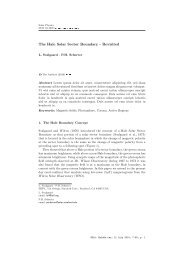
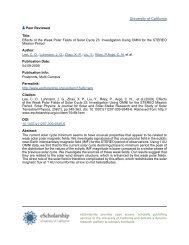

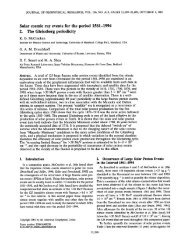

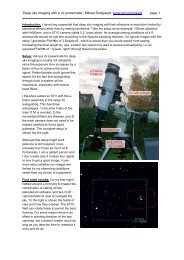
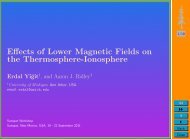
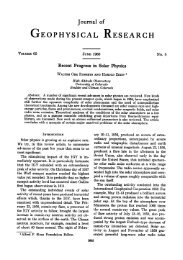
![The sum of two COSine waves is equal to [twice] the product of two ...](https://img.yumpu.com/32653111/1/190x245/the-sum-of-two-cosine-waves-is-equal-to-twice-the-product-of-two-.jpg?quality=85)
